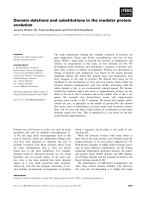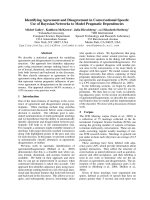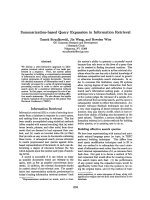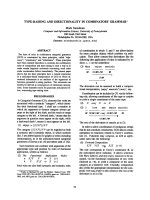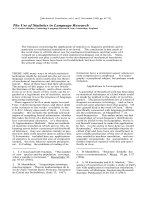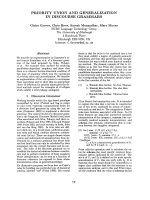Báo cáo khoa học: "PRIORITY UNION AND GENERALIZATION IN DISCOURSE GRAMMARS" doc
Bạn đang xem bản rút gọn của tài liệu. Xem và tải ngay bản đầy đủ của tài liệu tại đây (732.4 KB, 8 trang )
PRIORITY UNION AND GENERALIZATION
IN DISCOURSE GRAMMARS
Claire
Grover, Chris Brew, Suresh
Manandhar, Marc
Moens
HCRC Language Technology Group
The University of Edinburgh
2 Buccleuch Place
Edinburgh EH8 9LW, UK
Internet: C. Grover©ed. ac. uk
Abstract
We describe an implementation in Carpenter's ty-
ped feature formalism, ALE, of a discourse gram-
mar of the kind proposed by Scha, Polanyi,
et al. We examine their method for resolving
parallelism-dependent anaphora and show that
there is a coherent feature-structural rendition of
this type of grammar which uses the operations
of prwrity union and generalization. We describe
an augmentation of the ALE system to encompass
these operations and we show that an appropriate
choice of definition for priority union gives the de-
sired multiple output for examples of vP-ellipsis
which exhibit a strict/sloppy ambiguity.
1 Discourse Grammar
Working broadly within the sign-based paradigm
exemplified by HPSG (Pollard and Sag in press)
we have been exploring computational issues for
a discourse level grammar by using the
ALE
sy-
stem (Carpenter 1993) to implement a discourse
grammar. Our central model of a discourse gram-
mar is the Linguistic Discourse Model (LDM) most
often associated with Scha, Polanyi, and their co-
workers (Polanyi and Scha 1984, Scha and Polanyi
1988, Priist 1992, and most recently in Priist, Scha
and van den Berg 1994). In
LDM
rules are defi-
ned which are, in a broad sense, unification gram-
mar rules and which combine discourse constitu-
ent units (DCUS). These are simple clauses whose
syntax and underresolved semantics have been de-
termined by a sentence grammar but whose fully
resolved final form can only be calculated by their
integration into the current discourse and its con-
text. The rules of the discourse grammar act to
establish the rhetorical relations between constitu-
ents and to perform resolution of those anaphors
whose interpretation can be seen as a function of
discourse coherence (as opposed to those whose
interpretation relies on general knowledge).
For illustrative purposes, we focus here on Prfist's
rules for building one particular type of rhetorical
relation, labelled "list" (Priist 1992). His central
thesis is that for DCUs to be combined into a list
they must exhibit a degree of syntactic-semantic
parallelism and that this parallelism will strongly
determine the way in which some kinds of anaphor
are resolved. The clearest example of this is vP-
ellipsis as in (la) but Priist also claims that the
subject and object pronouns in (lb) and (lc) are
parallelism-dependent anaphors when they occur
in list structures and must therefore be resolved to
the corresponding fully referential subject/object
in the first member of the list.
(1) a. Hannah likes beetles. So does Thomas.
b. Hannah likes beetles. She also likes
caterpillars.
c. Hannah likes beetles. Thomas hates
them.
(2) is Priist's list construction rule. It is intended
to capture the idea that a list can be constructed
out of two DCUs, combined by means of connec-
tives such as and and or. The categories in Priist's
rules have features associated with them. In (2)
these features are sere (the unresolved semantic
interpretation of the category), consem (the con-
textually resolved semantic interpretation), and
schema (the semantic information that is com-
mon between the daughter categories).
(2) list [sere: el T~ ((Cl ¢'$2) RS2),
schema : C1 ¢ $2] 4
DCUI [ sem : Sl,consem : C1] +
DCU2 [sere : ~S2,consem : ((Cl ~'$2) ~$2)]
Conditions:
C1 • $2 is a characteristic generalization of C1
and S~; R E {and, or }.
Priist calls the operation used to calculate the va-
lue for schema the most specific common deno-
minator (MSCD, indicated by the symbol ¢). The
MSCD of C1 and $2 is defined as the most specific
generalization of C1 that can unify with 5'2. It is
essential that the result should be contentful to a
degree that confirms that the list structure is an
appropriate analysis, and to this end Pr/ist impo-
ses the condition that the value of schema should
17
be a
characteristic generalization
of the informa-
tion contributed by the two daughters. There is
no formal definition of this notion; it would re-
quire knowledge from many sources to determine
whether sufficient informativeness had been achie-
ved. However, assuming that this condition is met,
Priist uses the common information as a source for
resolution of underspecified elements in the second
daughter by encoding as the value of the second
daughter's consem the unification of the result of
MSCD with its pre-resolved semantics (the formula
((Ca / $2) Iq $2)). So in Priist's rule the MSCD
operation plays two distinct roles, first as a test for
parallelism (as the value of the mother's
schema)
and second as a basis for resolution (in the com-
posite operation which is the value of the second
daughter's consem). There are certain problems
with MSCD which we claim stem from this attempt
to use one operation for two purposes, and our pri-
mary concern is to find alternative means of achie-
ving Prfist's intended analysis.
2 An ALE Discourse
Grammar
For our initial exploration into using ALE for dis-
course grammars we have developed a small dis-
course grammar whose lexical items are complete
sentences (to circumvent the need for a sentence
grammar) and which represents the semantic con-
tent of sentences using feature structures of type
event
whose sub-types are indicated in the follo-
wing part of the type hierarchy:
event
(3)
agentive
plus_patient prop-art
emot-att
action believe
assume
like hate kick
catch
In addition we have a very simplified semantics of
noun phrases where we encode them as of type
entity
with the subtypes indicated below:
(4) entity
animate
human animal
female male
insect
4" ,
hannah jessy thomas sam brother
beetle bee
cater-
pillar
Specifications of which features are appropriate for
which type give us the following representations of
the semantic content of the discourse units in (1):
(5) a.
Hannah likes beetles
[ AGENT hannah ]
PATIENT
beetle
like
b. So does Thomas
[ AGENT thomas ]
agentive
c. She also likes caterpillars
[ AGENT female ]
PATIENT
caterpillar
like
d. Thomas hates them
[ AGENT thomas ]
PATIENT
entity
hate
2.1 Calculating Common Ground
The SCHEMA feature encodes the information that
is common between daughter Dcus and Prtist uses
MSCD to calculate this information. A feature-
structural definition of MSCD would return as a
result the most specific feature structure which is
at least as general as its first argument but which
is also unifiable with its second argument. For
the example in (lc), the MSCD operation would be
given the two arguments in (5a) and (5d), and (6)
would be the result.
(6)
[ AGENT human ]
PATIENT beetle
emot_att
We can contrast the
MSCD
operation with an
operation which is more commonly discussed in
the context of feature-based unification systems,
namely
generalization.
This takes two feature-
structures as input and returns a feature struc-
ture which represents the common information in
them. Unlike MSCD, generalization is not asym-
metric, i.e. the order in which the arguments are
presented does not affect the result. The genera-
lization of (5a) and (5d) is shown in (7).
(7) [ AGENT human ]
PATIENT
entity
emot_att
It can be seen from this example that the MSCD
result contains more information than the genera-
lization result. Informally we can say that it seems
to reflect the common information between the
two inputs
after the parallelism-dependent ana-
phor in the second sentence has been resolved.
The
reason it is safe to use MSCD in this context is pre-
cisely because its use in a
list
structure guarantees
18
that the pronoun in the second sentence will be
resolved to
beetle.
In fact the result of
MSCD
in
this case is exactly the result we would get if we
were to perform the generalization of the resolved
sentences and, as a representation of what the two
have in common, it does seem that this is more de-
sirable than the generalization of the pre-resolved
forms.
If we turn to other examples, however, we discover
that MSCD does not always give the best results.
The discourse in (8) must receive a constituent
structure where the second and third clauses are
combined to form a
contrast
pair and then this
contrast
pair combines with the first sentence to
form a
list.
(Prfist has a separate rule to build
contrast
pairs but the use of
MSCD is
the same as
in the
list
rule.)
(8) Hannah likes ants. Thomas likes bees but
Jessy hates them.
(9) fAGENT
hanna~
[._PATIENT
insect_.J
like
AGENT
hannah~
[AGENT
human~
PATIENT
ant _]
PATIENT
bee
_J
like e~
ATIENT
bee [
[-PATIENT
entity I
like
hate
The tree in (9) demonstrates the required struc-
ture and also shows on the mother and interme-
diate nodes what the results of
MSCD
would be. As
we can see, where elements of the first argument
of MSCD
are more specific than the corresponding
elements in the second, then the more specific one
occurs in the result. Here, this has the effect that
the structure
[like,
AGENT
hannah,
PATIENT ins-
ect
] is somehow claimed to be common ground
between all three constituents even though this is
clearly not the case.
Our solution to this problem is to dispense with
the MSCD operation and to use generalization in-
stead. However, we do propose that generalization
should take inputs whose parallelism dependent
anaphors have already been resolved. 1 In the case
of the combination of (5a) and (5d), this will give
1As described in the next section, we use priority
union to resolve these anaphors in both
lists and con-
trasts.
The use of generalization as a step towards
checking that there is sufficient common ground is sub-
sequent to the use of priority ration as the resolution
mechanism.
exactly the same result as MSCD gave (i.e.
(6)),
but for the example in (8) we will get different re-
sults, as the tree in (10) shows. (Notice that the
representation of the third sentence is one where
the anaphor is resolved.) The resulting generaliza-
tion,
[emot_att,
AGENT
human,
PATIENT
insect],
is
a much more plausible representation of the com-
mon information between the three DCUs than the
results of MSCD.
(10) fAGENT
huma~
[_PATIENT
insect~
ATIENT
ant
J
[_PATIENT
bee _J
like e~
LPATIENT
bee
_]
[_PATIENT
bee ._]
like
hate
2.2 Resolution of Parallel Anaphors
We have said that
MSCD
plays two roles in Pr/ist's
rules and we have shown how its function in cal-
culating the value of SCHEMA can be better served
by using the generalization operation instead. We
turn now to the composite operation indicated in
(2) by the formula ((C,
/S~)NS2).
This com-
posite operation calculates MSCD and then unifies
it back in with the second of its arguments in or-
der to resolve any parallelism-dependent anaphors
that might occur in the second DCU. In the discus-
sion that follows, we will refer to the first DcU in
the
list
rule as the
source
and to the second DCU
as the
target
(because it contains a parallelism-
dependent anaphor which is the target of our at-
tempt to resolve that anaphor).
In our ALE implementation we replace Pr/ist's
composite operation by an operation which has oc-
casionally been proposed as an addition to feature-
based unification systems and which is usually re-
ferred to either as
default unification
or as
priority
union. 2
Assumptions about the exact definition of
this operation vary but an intuitive description of
it is that it is an operation which takes two feature
structures and produces a result which is a merge
of the information in the two inputs. However,
the information in one of the feature structures is
"strict" and cannot be lost or overridden while the
information in the other is defensible. The opera-
tion is a kind of union where the information in
the strict structure takes priority over that in the
~See, for example, Bouma (1990), Calder (1990),
Carpenter (1994), Kaplan (1987).
19
default structure, hence our preference to refer to
it by the name priority union. Below we demon-
strate the results of priority union for the exam-
ples in (la)-(lc). Note that the target is the strict
structure and the source is the defeasible one.
(11)
Hannah likes beetles. So does Thomas.
Source: 5a
Target:
5b
Priority[ AGENT th°mas ]
Union: PATIENT
beetle
like
(12)
Hannah likes beetles. She
also likes
caterpillars.
Source: 5a
Target: 5c
[ AGENT hannah 1
Priority PATIENT
caterpillar
Union:
like
(13)
Hannah likes beetles. Thomas hates them.
Source: 5a
Target: 5d
AGENT
thomas ]
Priority PATIENT
beetle
Union:
hate
For these examples priority union gives us exactly
the same results as Priist's composite operation.
We use a definition of priority union provided by
Carpenter (1994) (although note that his name for
the operation is "credulous default unification").
It is discussed in more detail in Section 3. The pri-
ority union of a target T and a source S is defined
as a two step process: first calculate a maximal
feature structure S' such that S' E S, and then
unify the new feature structure with T.
This is very similar to PriJst's composite opera-
tion but there is a significant difference, however.
For Priist there is a requirement that there should
always be a unique MSCD since he also uses MSCD
to calculate the common ground as a test for par-
allelism and there must only be one result for that
purpose. By contrast, we have taken Carpenter's
definition of credulous default unification and this
can return more than one result. We have strong
reasons for choosing this definition even though
Carpenter does define a "skeptical default unifi-
cation" operation which returns only one result.
Our reasons for preferring the credulous version
arise from examples of vP-ellipsis which exhibit an
ambiguity whereby both a "strict" and a "sloppy"
reading are possible. For example, the second sen-
tence in (14) has two possible readings which can
be glossed as "Hannah likes Jessy's brother" (the
strict reading) and "Hannah likes her own bro-
ther" (the sloppy reading).
(14) Jessy likes her brother. So does Hannah.
The situations where the credulous version of the
operation will return more than one result arise
from structure sharing in the defeasible feature
structure and it turns out that these are exactly
the places where we would need to get more than
one result in order to get the strict/sloppy ambi-
guities. We illustrate below:
(15)
Jessy likes her
brother. So
does Hannah.
Source:
AGENT
PATIENT
like
~]jessy ]
[] ]
brother
Target:
[ AGENT hannah ]
agentive
Priority
Union:
" AGENT
PATIENT
like
[] hannah 1
[ nl]
brother
AGENT
PATIENT
like
hannah ]
[
brother
Here priority union returns two results, one where
the structure-sharing information in the source has
been preserved and one where it has not. As the
example demonstrates, this gives the two readings
required. By contrast, Carpenter's skeptical de-
fault unification operation and Priist's composite
operation return only one result.
2.3 Higher Order Unification
There are similarities between our implementa-
tion of Prfist's grammar and the account of vP-
ellipsis described by Dalrymple, Shieber and Pe-
reira (1991) (henceforth DSP). DSP gives an
equational characterization of the problem of vp-
ellipsis where the interpretation of the target
phrase follows from an initial step of solving an
equation with respect to the source phrase. If a
function can be found such that applying that fun-
ction to the source subject results in the source in-
terpretation, then an application of that function
to the target subject will yield the resolved inter-
pretation for the target. The method for solving
such equations is "higher order unification". (16)
shows all the components of the interpretation of
the example in (11).
20
(16)
Hannah likes beetles. So does Thomas.
Source:
Target (T):
Equation:
Solution:
Apply to T:
like(hannah, beetle)
P ( thomas )
P ( hannah ) = like(hannah, beetle)
P = ~x.like(x, beetle)
like(thomas, beetle)
A prerequisite to the DSP procedure is the esta-
blishment of parallelism between source and target
and the identification of parallel subparts. For ex-
ample, for (16) it is necessary both that the two
clauses
Hannah likes beetles
and
So does Thomas
should be parallel and that the element
hannah
should be identified as a parallel element. DSP
indicate parallel elements in the source by means
of underlines as shown in (16). An underlined ele-
ment in the source is termed a 'primary occur-
rence' and DSP place a constraint on solutions to
equations requiring that primary occurrences be
abstracted. Without the identification of
hannah
as a primary occurrence in (16), other equations
deriving from the source might be possible, for ex-
ample (17) :
(17) a.
P(beetle) = like(hannah, beetle)
b. P(like) = like(hannah, beetle)
The DSP analysis of our strict/sloppy example in
(14) is shown in (18). The ambiguity follows from
the fact that there are two possible solutions to the
equation on the source: the first solution involves
abstraction of just the primary occurrence
ofjessy,
while the second solution involves abstraction of
both the primary and the secondary occurrences.
When applied to the target these solutions yield
the two different interpretations:
(18)
Jessy
Source:
Target:
Equation:
Sol.1 ($1):
Sol.2 (S2):
Apply SI:
Apply $2:
likes her brother. So does Hannah.
like(jessy, brother-of (jessy) )
P( hannah )
P(jessy) = like(jessy, brother-of (jessy) )
P = ~x.like(x, brother-of(jessy))
e = Ax.like(x, brother-of(x))
like(hannah, brother-of (jessy) )
like(hannah, brother-of(hannah))
DSP claim that a significant attribute of their ac-
count is that they can provide the two readings in
strict/sloppy ambiguities without having to postu-
late ambiguity in the source. They claim this as
a virtue which is matched by few other accounts
of vP-ellipsis. We have shown here, however, that
an account which uses priority union also has no
need to treat the source as ambiguous.
Our results and DSP's also converge where the
treatment of cascaded ellipsis is concerned. For
the example in (19) both accounts find six rea-
dings although two of these are either extremely
implausible or even impossible.
(19) John revised his paper before the teacher
did, and Bill did too.
DSP consider ways of reducing the number of
readings and, similarly, we are currently explo-
ring a potential solution whereby some of the re-
entrancies in the source are required to be trans-
mitted to the result of priority union.
There are also similarities between our account
and the DSP account with respect to the esta-
blishment of parallelism. In the DSP analysis the
determination of parallelism is separate from and
a prerequisite to the resolution of ellipsis. Howe-
ver, they do not actually formulate how paralle-
lism is to be determined. In our modification of
Prfist's account we have taken the same step as
DSP in that we separate out the part of the fea-
ture structure used to determine parallelism from
the part used to resolve ellipsis. In the general
spirit of Priist's analysis, however, we have taken
one step further down the line towards determi-
ning parallelism by postulating that calculating
the generalization of the source and target is a
first step towards showing that parallelism exists.
The further condition that Prfist imposes, that the
common ground should be a characteristic genera-
lization, would conclude the establishment of par-
allelism. We are currently not able to define the
notion of characteristic generalization, so like DSP
we do not have enough in our theory to fully imple-
ment the parallelism requirement. In contrast to
the DSP account, however, our feature structural
approach does not involve us having to explicitly
pair up the component parts of source and target,
nor does it require us to distinguish primary from
secondary occurrences.
2.4 Parallelism
In the DSP approach to vP-ellipsis and in our ap-
proach too, the emphasis has been on semantic
parallelism. It has often been pointed out, howe-
ver, that there can be an additional requirement of
syntactic parallelism (see for example, Kehler 1993
and Asher 1993). Kehler (1993) provides a use-
ful discussion of the issue and argues convincingly
that whether syntactic parallelism is required de-
pends on the coherence relation involved. As the
examples in (20) and (21) demonstrate, semantic
parallelism is sufficient to establish a relation like
contrast
but it is not sufficient for building a co-
herent
list.
(20) The problem was looked into by John, but
no-one else did.
(21) *This problem was looked into by John,
and Bill did too.
For a
list
to be well-formed both syntactic and
semantic parallelism are required:
21
(22) John looked into this problem, and Bill did
too.
In the light of Kehler's claims, it would seem that
a more far-reaching implementation of our prio-
rity union account would need to specify how the
constraint of syntactic parallelism might be imple-
mented for those constructions which require it.
An nPSG-style sign, containing as it does all types
of linguistic information within the same feature
structure, would lend itself well to an account of
syntactic parallelism. If we consider that the
DTRS
feature in the sign for the source clause contains
the entire parse tree including the node for the
vP which is the syntactic antecedent, then ways
to bring together the source vP and the target be-
gin to suggest themselves. We have at our disposal
both unification to achieve re-entrancy and the op-
tion to use priority union over syntactic subparts
of the sign. In the light of this, we are confident
that it would be possible to articulate a more ela-
borate account of vp-ellipis within our framework
and that priority union would remain the opera-
tion of choice to achieve the resolution.
3 Extensions to ALE
In the previous sections we showed that Prfist's
MSCD operation would more appropriately be re-
placed by the related operations of generalization
and priority union. We have added generalization
and priority union to the ALE system and in this
section we discuss our implementation. We have
provided the new operations as a complement to
the definite clause component of
ALE.
We chose
this route because we wanted to give the gram-
mar writer explicit control of the point at which
the operations were invoked.
ALE
adopts a sim-
ple eROLOG-like execution strategy rather than
the more sophisticated control schemes of systems
like CUF and TFS (Manandhar 1993). In princi-
ple it might be preferable to allow the very gene-
ral deduction strategies which these other systems
support, since they have the potential to support a
more declarative style of grammar-writing. Unfor-
tunately, priority union is a non-monotonic ope-
ration, and the consequences of embedding such
operations in a system providing for flexible exe-
cution strategies are largely unexplored. At least
at the outset it seems preferable to work within a
framework in which the grammar writer is requi-
red to take some of the responsibility for the order
in which operations are carried out. Ultimately we
would hope that much of this load could be taken
by the system, but as a tool for exploration
ALE
certainly suffices.
3.1 Priority Union in
ALE
We use the following definition of priority union,
based on Carpenter's definition of credulous de-
fault unification:
(23) punion(T,S) = {unify(T,S') IS' K S
is maximal such that unify(T,S') is defined}
punion(T,S) computes the priority union oft (tar-
get; the strict feature structure) with S (source;
the defeasible feature structure). This definition
relies on Moshier's (1988) definition of
atomic fea-
ture structures,
and on the technical result that
any feature structure can be decomposed into a
unification of a unique set of atomic feature struc-
tures. Our implementation is a simple procedura-
lization of Carpenter's declarative definition. First
we decompose the default feature structure into a
set of atomic feature structures, then we search for
the maximal subsets required by the definition.
We illustrate our implementation of priority union
in
ALE
with the example in (15):
Source
is the de-
fault input, and
Target
is the strict input. The
hierarchy we assume is the same as shown in (3)
and (4). Information about how features are asso-
ciated with types is as follows:
• The type
agentive
introduces the feature AGENT
with range type
human.
• The type
plus-patient
introduces the feature
PA-
TIENT
with range type
human.
• The type
brother
introduces the feature
BROTHER-OF with range type
human.
• The types
jessy
and
hannah
introduce no fea-
tures.
In order to show the decomposition into ato-
mic feature structures we need a notation to re-
present paths and types. We show paths like
this:
PATIENTIBROTHER-OF
and in order to sti-
pulate that the PATIENT feature leads to a struc-
ture of type
brother,
we include type informa-
tion in this way:
(PATIENW/brother)[(BROTHER-
of~human).
We introduce a special feature (*)
to allow specification of the top level type of the
structure. The structures in (15) decompose into
the following atomic components.
(24) Default input:
( AGENT / jessy)
( D 1 )
(PATIENT/brother)I(BROTHER-OF/jessy)
(D2)
AGENT ~ PATIENTIBROTHER-OF
(D3)
(*/like)
(D4)
Strict input:
(AGENT~hannah) (S 1 )
( * / agentive)
($2)
Given the type hierarchy the expressions above ex-
pand to the following typed feature structures:
22
(25)
Default input:
[ AGENT jessy ]
agentive
AGENT
PATIENT
plus-patient
AGENT
PATIENT
plus-patient
AGENT
human ]
PATIENT
entity
like
human 1
brother
human ]
]
brother
(D1)
(D2)
(D3)
(D4)
Strict input:
[ AGENT hannah ]
agentive
(s1,s2)
We can now carry out the following steps in order
to generate the priority union.
1. Add (94) to the strict input. It cannot conflict.
2. Note that it is impossible to add (D1) to the
strict input.
3. Non-deterministically add either (92) or (93)
to the strict input.
4. Note that the results are maximal in each case
because it is impossible to add both (D2) and
(D3) without causing a clash between the dis-
joint atomic types
hannah
and
jessy.
5. Assemble the results into feature structures. If
we have added (D3) the result will be (26) and
if we have added (D2) the result will be (27).
(26) Result 1:
" AGENT
[] hannah ]
PATIENT [BROTHER-OF [] ]
]
brother
like
(27) Result 2:
AGENT
PATIENT
like
hannah ]
[BROTHER-OFjessy]
brother
In order to make this step-by-step description into
an algorithm we have used a breadth-first search
routine with the property that the largest sets are
generated first. We collect answers in the order in
which the search comes upon them and carry out
subsumption checks to ensure that all the answers
which will be returned are maximal. These checks
reduce to checks on subset inclusion, which can be
reasonably efficient with suitable set representati-
ons. Consistency checking is straightforward be-
cause the ALE system manages type information
in a manner which is largely transparent to the
user. Unification of ALE terms is defined in such a
way that if adding a feature to a term results in a
term of a new type, then the representation of the
structure is specialized to reflect this. Since prio-
rity union is non-deterministic we will finish with
a set of maximal consistent subsets. Each of these
subsets can be converted directly into ALE terms
using ALE's built-in predicate add_to/5. The re-
sulting set of ALE terms is the (disjunctive) result
of priority union.
In general we expect priority union to be a com-
putationally expensive operation, since we cannot
exclude pathological cases in which the system has
to search an exponential number of subsets in the
search for the maximal consistent elements which
are required. In the light of this it is fortunate
that our current discourse grammars do not re-
quire frequent use of priority union. Because of
the inherent complexity of the task we have fa-
voured correctness and clarity at the possible ex-
pense of efficiency. Once it becomes established
that priority union is a useful operation we can
begin to explore the possibilities for faster imple-
mentations.
3.2 Generalization in
ALE
The abstract definition of
generalization
stipulates
that the generalization of two categories is the lar-
gest category which subsumes both of them. Mos-
hier (1988) has shown that generalization can be
defined as the intersection of sets of atomic fea-
ture structures. In the previous section we outli-
ned how an ALE term can be broken up into atomic
feature structures. All that is now required is the
set intersection operation with the addition that
we also need to cater for the possibility that ato-
mic types may have a consistent generalization.
1. For P and Q complex feature structures
Gen(P,Q) =~! {Path: C I Path: A E P
and
Path
: B E Q } where C is the most
specific type which subsumes both A and B.
2. For A and B atomic types
Gen(A, B)
=dr C
where C is the most specific type which subsu-
mes both A and B.
In ALE there is always a unique type for the gene-
ralization. We have made a small extension to the
ALE compiler to generate a table of type genera-
lizations to assist in the (relatively) efficient com-
putation of generalization. To illustrate, we show
how the generalization of the two feature structu-
res in (28) and (29) is calculated.
23
(28)
(29)
Hannah likes ants.
AGENT
hannah ]
PATIENT
ant
like
Jessy laughs.
[AGENT
jessy ]
laugh
These decompose into the atomic components
shown in (30) and (31) respectively.
(30)
(*/like)
(AGENT/hannah)
(PATIENT/ant)
(31) (*/Za.gh)
(AGENT/jessy)
These have only the AGENT path in common alt-
hough with different values and therefore the ge-
neralization is the feature structure corresponding
to this path but with the generalization of the ato-
mic types
hannah
and
jessy as
value:
(32) [ AGENT
female ]
agentive
4 Conclusion
In this paper we have reported on an implemen-
tation of a discourse grammar in a sign-based for-
malism, using Carpenter's Attribute Logic Engine
(aLE). We extended the discourse grammar and
ALE to incorporate the operations of priority union
and generalization, operations which we use for
resolving parallelism dependent anaphoric expres-
sions. We also reported on a resolution mecha-
nism for verb phrase ellipsis which yields sloppy
and strict readings through priority union, and we
claimed some advantages of this approach over the
use of higher-order unification.
The outstanding unsolved problem is that of esta-
blishing parallelism. While we believe that gene-
ralization is an appropriate formal operation to
assist in this, we still stand in dire need of a con-
vincing criterion for judging whether the genera-
lization of two categories is sufficiently informative
to successfully establish parMlelism.
Acknowledgements
This work was supported by the EC-funded project
LRE-61-062 "Towards a Declarative Theory of Dis-
course" and a longer version of the paper is available
in Brew
et al
(1994). We have profited from discus-
sions with Jo Calder, Dick Crouch, Joke Dorrepaal,
Claire Gardent, Janet Hitzeman, David Millward and
Hub Prfist. Andreas Schhter helped with the imple-
mentation work. The Human Communication Rese-
arch Centre (HCRC) is supported by the Economic
and Social Research Council (UK).
References
Asher, N. (1993)
Reference to Abstract Objects in Di-
scourse.
Dordrecht: Kluwer.
Bouma, G. (1990) Defaults in Unification Grammar.
In
Proceedings of the 28th ACL,
pp. 165-172, Uni-
versity of Pittsburgh.
Brew, C.
et al
(1994)
Discourse Representation.
De-
liverable B+ of LRE-61-062: Toward a Declarative
Theory of Discourse.
Calder, J. H. R. (1990)
An Interpretation of Paradig-
matic Morphology.
PhD thesis, Centre for Cognitive
Science, University of Edinburgh.
Carpenter, B. (1993) ALE. The Attribute Logic En-
gine user's guide, version ~. Laboratory for Com-
putational Linguistics, Carnegie Mellon University,
Pittsburgh, Pa.
Carpenter, B. (1994) Skeptical and credulous default
unification with applications to templates and inhe-
ritance. In T. Briscoe et al, eds.,
Inheritance, De-
faults, and the Lexicon,
pp. 13-37. Cambridge: Cam-
bridge University Press.
Dalrymple, M., S. Shieber and F. Pereira (1991) El-
lipsis and higher-order unification.
Linguistics and
Philosophy
14(4), 399-452.
Kaplan, R. M. (1987) Three seductions of computa-
tional psycholinguistics. In P. J. Whitelock et al,
eds.,
Linguistic Theory and Computer Applications,
pp. 149-188. London: Academic Press.
Kehler, A. (1993) The effect of establishing coherence
in ellipsis and anaphora resolution. In
Proceedings
of the 31st ACL,
pp. 62-69, Ohio State University.
Manandhar, S. (1993) CUF in context. In J. Dbrre, ed.,
Computational Aspects of Constraint-Based Lingui-
stics Description.
DYANA-2 Deliverable.
Moshier, D. (1988)
Extensions to Unification Gram-
mar for the Description of Programming Languages.
PhD thesis, Department of Mathematics, University
of California, Los Angeles.
Polanyi, L. and R. Scha (1984) A syntactic approach
to discourse semantics. In
Proceedings of the tOth
Coling and the 22nd ACL,
pp. 413-419, Stanford
University.
Pollard, C. and I. A. Sag (in press)
Head-Driven
Phrase Structure Grammar.
Chicago, Ill.: Univer-
sity of Chicago Press and CSLI Publications.
Priist, H. (1992)
On Discourse Structuring, VP Ana-
phora and Gapping.
PhD thesis, Universiteit van
Amsterdam, Amsterdam.
Pr/Jst, H., R. Scha and M. van den Berg (1994} Dis-
course grammar and verb phrase anaphora.
Lingui-
stics and Philosophy.
To appear.
Scha, R. and L. Polanyi (1988) An augmented context
free grammar for discourse. In
Proceedings of the
12th Coling,
pp. 573-577, Budapest.
24

